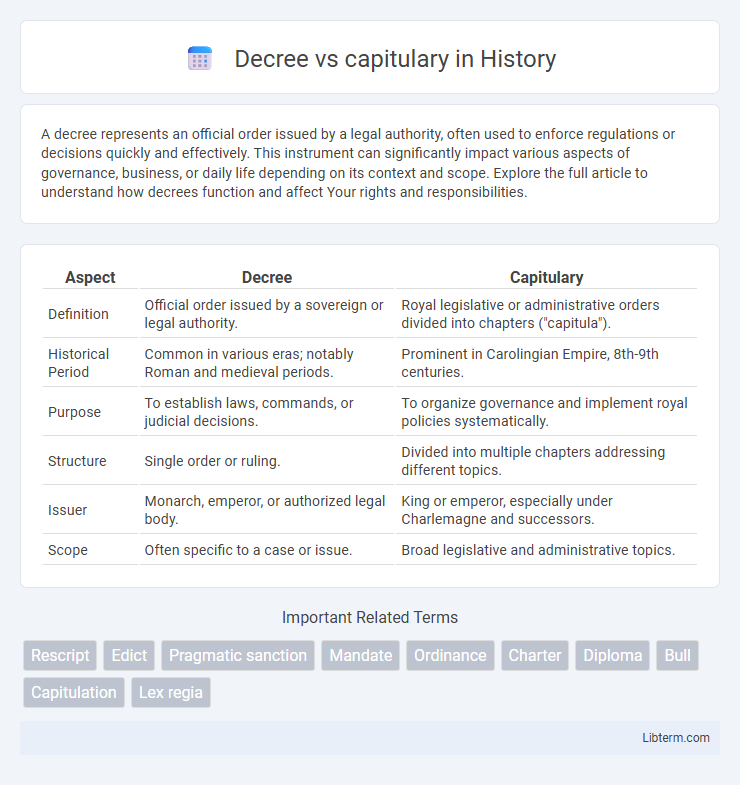A decree represents an official order issued by a legal authority, often used to enforce regulations or decisions quickly and effectively. This instrument can significantly impact various aspects of governance, business, or daily life depending on its context and scope. Explore the full article to understand how decrees function and affect Your rights and responsibilities.
Table of Comparison
| Aspect | Decree | Capitulary |
|---|---|---|
| Definition | Official order issued by a sovereign or legal authority. | Royal legislative or administrative orders divided into chapters ("capitula"). |
| Historical Period | Common in various eras; notably Roman and medieval periods. | Prominent in Carolingian Empire, 8th-9th centuries. |
| Purpose | To establish laws, commands, or judicial decisions. | To organize governance and implement royal policies systematically. |
| Structure | Single order or ruling. | Divided into multiple chapters addressing different topics. |
| Issuer | Monarch, emperor, or authorized legal body. | King or emperor, especially under Charlemagne and successors. |
| Scope | Often specific to a case or issue. | Broad legislative and administrative topics. |
Definition of Decree
A decree is an authoritative order issued by a head of state or a sovereign authority, often carrying the force of law without requiring legislative approval. In contrast, a capitulary refers to a collection of legislative or administrative orders issued primarily during the Carolingian dynasty, typically structured as chapters addressing various aspects of governance. The decree serves as a singular, binding mandate, while capitularies represent compiled regulations aimed at comprehensive administrative control.
Definition of Capitulary
A capitulary is a set of legislative or administrative orders issued by Frankish kings, primarily during the Carolingian era, organized into chapters called "capitula." These decrees functioned as important legal instruments to govern territories, regulate dioceses, and standardize practices across the empire. Unlike a broader decree, which may encompass a single edict or proclamation, capitularies represent a systematic compilation of regulations addressing various aspects of governance and society.
Historical Origins of Decrees
Decrees originated in ancient legal traditions as authoritative orders issued by sovereign rulers or governing bodies to regulate public and administrative matters. Unlike capitularies, which were collections of legislative acts primarily issued by Frankish kings during the early medieval period, decrees have a broader historical scope, tracing back to Roman imperial edicts and Byzantine imperial mandates. These early decrees established foundational legal precedents influencing the structure of modern legislation.
Historical Origins of Capitularies
Capitularies originated during the Carolingian dynasty in the 8th and 9th centuries as royal legislative assemblies issued by Frankish rulers like Charlemagne to organize administrative, judicial, and ecclesiastical matters. These documents were divided into sections called "capitula," which facilitated the codification of laws and decrees issued across the empire, reflecting a systematic approach to governance. In contrast, decrees are broader authoritative orders or decisions that have varied origins across different historical periods and legal systems.
Structure and Format Differences
Decrees typically consist of formal, authoritative proclamations issued by a sovereign or high authority, structured with clear hierarchical clauses, and often organized into numbered paragraphs or articles for precise legal referencing. Capitularies, issued primarily by Frankish kings like Charlemagne, feature a more segmented format divided into 'capitula' or chapters, each addressing specific issues or administrative rules, reflecting a modular approach to governance. The format of capitularies tends to be more varied and less unified compared to the rigid, codified structure of decrees, emphasizing practical implementation over formalistic style.
Legal Authority and Scope
Decrees possess formal legal authority issued by a sovereign or government, often carrying binding force over an entire jurisdiction or specific sectors. Capitularies are legislative or administrative edicts primarily issued during the Carolingian Empire, addressing diverse matters ranging from church regulations to public administration with localized or thematic scope. The legal authority of decrees typically surpasses capitularies, as decrees invoke supreme power, whereas capitularies serve more as regulatory guidelines within a defined framework.
Use in Governance and Administration
Decrees served as formal orders issued by rulers or legal authorities to enforce laws, policies, and administrative decisions within governance structures. Capitularies consisted of structured legislative acts issued by Frankish kings, notably Charlemagne, to regulate various aspects of administration, justice, and local governance across the empire. Both instruments played crucial roles in organizing government functions, with decrees often addressing immediate legal matters and capitularies providing comprehensive guidelines for administrative governance.
Key Examples from History
Decrees, such as the 380 AD Edict of Thessalonica issued by Emperor Theodosius I, established Christianity as the Roman Empire's official religion, reflecting authoritative legal pronouncements. Capitularies, exemplified by Charlemagne's 789 Capitulary of Herstal, functioned as royal legislative acts regulating administrative and judicial matters across the Carolingian Empire. These key historical documents illustrate the distinction between imperial decrees, often singular pronouncements, and capitularies, which comprised collections of instructions or laws addressing a broad range of governance issues.
Comparison: Decree vs Capitulary
Decrees are authoritative orders issued by monarchs or ecclesiastical authorities primarily to regulate church or state matters, often carrying the force of law. Capitulary refers to a series of legislative or administrative acts issued by Frankish kings, notably Charlemagne, structured into chapters (capitula) to address governance and legal reform across their territories. While decrees tend to be single, comprehensive orders, capitularies are collections of short, specific provisions designed for systematic implementation in diverse regions.
Modern Relevance and Legacy
Decrees, as formal authoritative orders, continue to shape modern legal systems by providing frameworks for executive decisions and administrative regulations. Capitularies, historical legislative acts from the Carolingian era, influenced the development of codified law and regulatory practices in European governance. Their legacy persists in modern statutory law, highlighting the evolution of governance from monarchic edicts to contemporary legislative processes.
Decree Infographic

 libterm.com
libterm.com